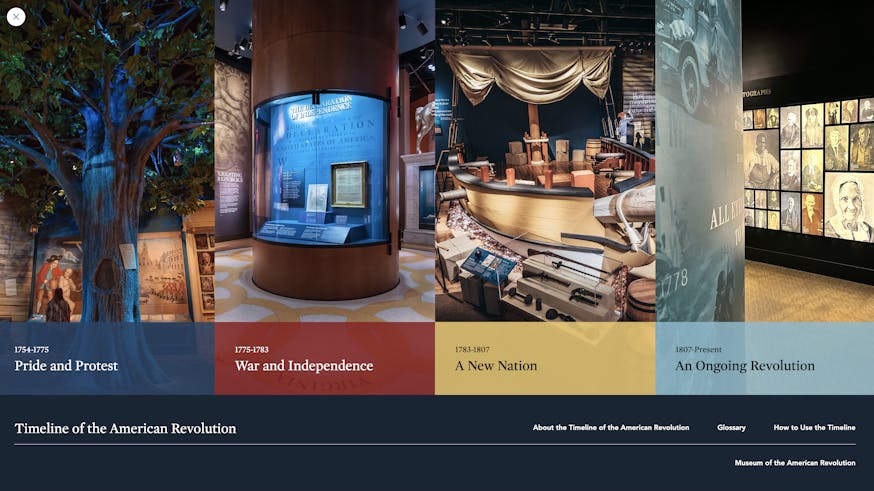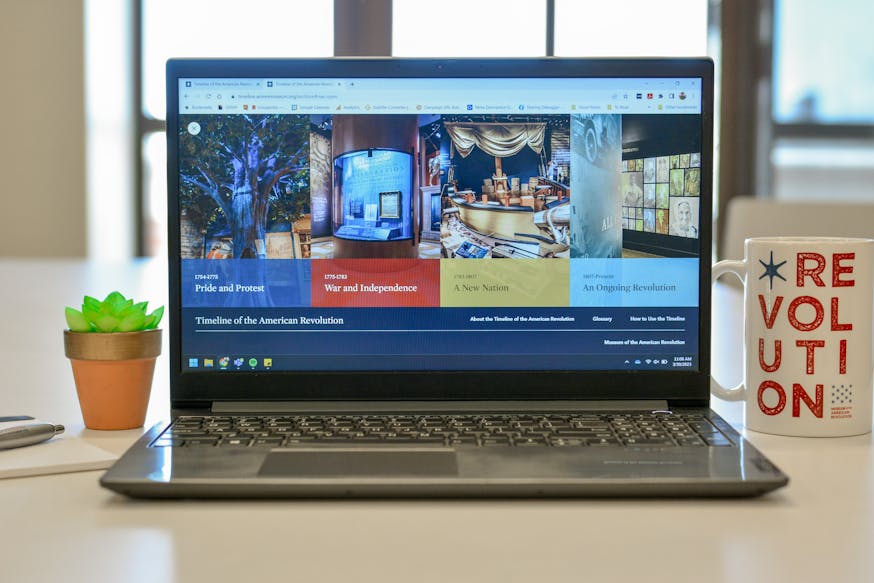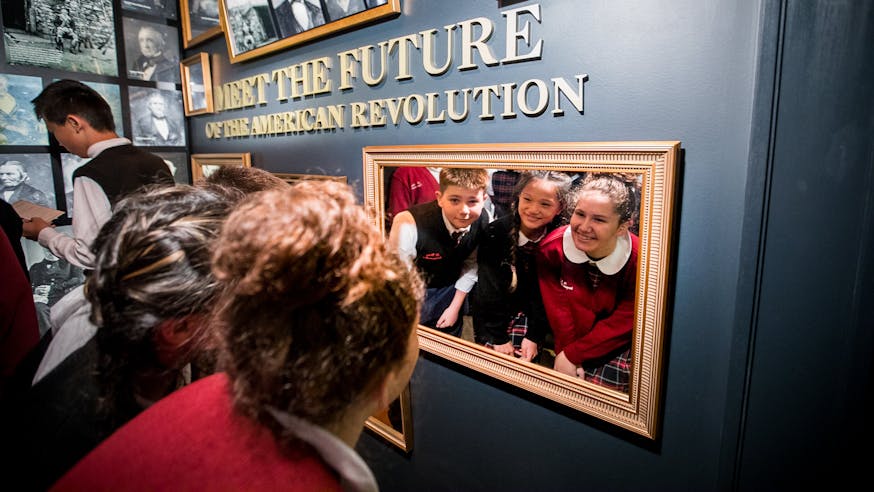Timeline of the American Revolution
Part 1: Teaching with Objects, Documents, and Timelines
The companion teacher guide for the Museum's Timeline of the American Revolution features a variety of activities of different lengths to help students learn about the Revolutionary era and the ongoing Revolution using historical objects, documents, and timelines.
Notes for Teachers
Ensure students have access to computers, tablets, or other devices with a working internet connection to access the Timeline of the American Revolution. The Timeline can also be downloaded onto computers and other personal devices.
Content Warning: This Timeline of the American Revolution, like the Museum’s collection, includes a variety of 18th-century weapons, including firearms. These objects can invite comparisons to and/or discussions of contemporary issues. Please use your discretion and understanding of your students and community when introducing and using this resource with your students.
Engagement Activities
These activities (5-10 minutes each) can be used as a hook activity, introduction to a concept, or shorter lesson.
OBJECT INVESTIGATION
You can start a class on the American Revolution with an object from the Timeline! Select an object that connects to a theme, person, place, event, or time within the Revolution that you plan to explore with your students. Project or display the object or allow students time to examine it on their personal devices. Note that objects can be magnified to see small details. Have students practice their historical thinking skills by conducting a close-looking exercise with the object:
Begin by observing/investigating the object and noting the following:
- Size, shape, and weight
- Color and texture
- 2-5 details that you find interesting
Then, invite students to draw conclusions about the object, based on their investigation, with the following questions as a guide:
- What might this object have been used for?
- Who might have made it? When and how? And why?
- What stories might this object tell?
- Did you learn anything from this object that was different from what you would find in a textbook?
- What might this object tell us about the American Revolution?
Use your students’ responses and curiosity to transition into your next activity or discussion around your person, place, event, or theme. (Consider using this object-based activity as a template for lessons on other historical eras as well.)
CLOSE LOOKING WITH A POWDER HORN
Note: This activity can be done with another object or objects from the Timeline but powder horns are often deeply decorated and provide lots of opportunity for noticing details and raising questions about the people who created, decorated, and carried them.
Powder Horns in the Timeline of the American Revolution:
- Havana Powder Horn (Pride and Protest)
- Abel Scott’s Powder Horn (War and Independence)
- William Waller Powder Horn (War and Independence)
- Samuel Dudley’s Powder Horn (War and Independence)
First, have students choose one of the powder horns or assign them one individually or in a group. Allow them a few minutes to locate the powder horn on the Timeline and write down their first observations (size, shape, weight, texture).
Then, ask them to use the zoom-in function to examine the horn more deeply, noticing as many details as possible. Tell students to also read the description of the powder horn. Afterwards, engage them in conversation around the following questions:
- What new observations about the powder horn were you able to make by looking at it more closely?
- What can all of these observations tell us about the soldier who carried the powder horn and his experiences in the Revolutionary War?
- How can close looking help us further understand an object and the person who may have used it?
- How can close looking help us further understand the person who might have made the object?
EXTEND: Have students pick an object in your classroom and do the same activity. What did close looking reveal about the object and the people who interact with it?
YOUR TIMELINE
Engage students in a conversation around the following questions:
- If you made a timeline of your life, what five objects or documents would you choose?
- What stories would they tell about you?
DO IT FOR THE ‘GRAM
Have students find one object or document from the Timeline. Then, instruct them to create a video reel or post (in the style of your/their preferred social media platform) describing what the object reveals about the American Revolution. Make sure to share it with us at @AmRevMuseum.
Development Activities
These activities (30-45 minutes) can be used for an entire class period.
WHAT IS A TIMELINE?
Ask students if they know what a timeline is. Then ask what purpose(s) timelines serve. Next, assign students individually to list the events of their day along with what mood or feelings they experience at several points during the day and then put them on a timeline.
Then, engage students in conversation around the following questions:
- Were there any correlations or connections between your mood and the events that happen to you during the day?
- How does organizing information help us better understand it?
- Why would historians use timelines for historic events?
MY TIMELINE OF THE AMERICAN REVOLUTION
Have your students create their own personalized Timeline of the American Revolution using the My Timeline feature. Students can pick objects based on their topic of interest, objects they want to learn more about, or objects they like the look of or a broad category. (Suggest a desired number of objects appropriate to your available time and your knowledge of your students.)
Begin by projecting or having students watch the short How to Use the Timeline of the American Revolution video.
Allow students the opportunity to create their own Timeline of the American Revolution. After students have created their timeline, engage them in conversation around the following questions:
- Why did you choose the specific objects/documents you did?
- How did each object/document help you better understand the American Revolution?
- Which document/object surprised you the most? Why?
- If you could go back in time and ask a question to the author of a document or a person who made or used one of your objects, what would it be and why?
EXTEND: Have students write a paragraph for each object or document explaining what caused them to choose it and how it can help to learn about the American Revolution.
OBJECT CONNECTIONS
Teacher preparation: Prepare copies of the Timeline of the American Revolution Contents handout. Cut out one object or document for each student.
Assign students an object or document from the Timeline by placing the name of the object/document in a hat or other container. Allow students time to find the object/ document on the Timeline and then to read about and examine the object. Then, tell students they have 5-10 minutes to walk around the classroom to find another student with an object that connects to theirs in some way. (If there is an odd number of students, there can be a group of three.) Give students a few minutes to talk to each other about their objects. Repeat the activity a few times. Afterwards, allow time to engage students in conversation around the following questions:
- What were some ways your object was connected to others in the class?
- Did this activity make you think about the object or document in a different way? How so?
- How can objects and documents give clues about how some historical events or ideas are connected?
CHOOSE ME!
After students have had time to browse the Timeline of the American Revolution, have them go to the Virtual Museum Tour and choose one object or document they feel should be included in the Timeline (that isn’t already in it). Ask them to justify their reasoning in a persuasive essay or speech to the class.
TIMELINE MARKETPLACE
Have students browse the Timeline and choose one object to “sell.” Ask students to consider the following:
- What function did this object serve?
- Are there any signs, symbols, or decorations on it? If so, how might they make this object more appealing to a particular person?
- Based on observable details, who do you think would have used this object? Who might have been able to afford it?
After answering the above questions, instruct students to use the information they gathered from the Timeline and the questions they answered to create a flier advertisement for the object in order to try to sell it.
EXTEND: Have students display their advertisements at their desks with an empty jar and provide each student with a small amount of play money or tickets. Instruct them to deposit money or a ticket into the corresponding jars of the objects with the most compelling advertisements. Select the objects with the most money/tickets for a class-wide discussion about their properties.
Research Projects
THEN AND NOW
Have students choose an object from the Timeline and then investigate it to see what it can tell them about what life was like during the Revolution. Then, instruct students to research what advancements have been made on their object. Students can then create a timeline of improvements and conclude by considering how the object is used today compared to during the American Revolution, and what this says about how life, technology, and the world has changed. Conclude by leading a discussion about what people today still have in common with those that lived during the Revolution, as well as what differences now exist.
EVERYTHING, EVERYWHERE, ALL IN ONE OBJECT
Assign each student a different object from the Timeline or have them choose an object. Tell students they have a challenge: They have to teach as much as they can about the American Revolution using only this object. Challenge students to find ways that the object can be used to introduce different groups of people, events, geography, economics, cultural events, etc. Have them present their findings to the class in the form of a PowerPoint, Prezi, Canva, song or performance.
MY EVENT
After students have had time to browse the Timeline of the American Revolution as an example, have students choose any historical event of interest to them and create a timeline of that event using only objects and documents.
MAKE A VIDEO
The following objects on the Timeline feature videos providing further information narrated by Museum Educators and Curators.
- Stamp Act Stamp
- “GR” Chamber Pot
- Phillis Wheatley’s Poetry Book
- Thomas Paine’s Common Sense and James Chalmers’ Plain Truth
- Hessian Headgear
- Letter about a Council with Native Americans
- Rappahannock Forge Musket
- The Female Review
- Lafayette Parade Banner
- World War II Poster
Assign students to watch a few of them and then have them take a turn! Have students pick an object from the Timeline to create their own video. Make sure to share them with us at [email protected].
EXTEND: Have students pick a video to watch. Afterwards, have them think of three questions they want to ask the Museum’s Education Department about the object or document. Send the questions to [email protected].
CREATE YOUR OWN MUSEUM OF THE AMERICAN REVOLUTION TIMELINE
First, have students explore the Timeline of the American Revolution focusing on the features of the Timeline (how to find objects with the filters, the length of object descriptions, themes and types of objects and documents). Then, have them choose one of the Museum of the American Revolution’s online exhibits to research. Tell them they are going to create a timeline of the exhibit, using 4 themes (some exhibits already have these themes) and 5-10 objects per theme to include on their timeline.
- Among His Troops: Washington’s War Tent in a Newly Discovered Watercolor
- Black Founders: The Forten Family of Philadelphia
- Cost of Revolution: The Life and Death of an Irish Soldier
- Liberty: Don Troiani’s Paintings of the Revolutionary War
- When Women Lost the Vote: A Revolutionary Story, 1776-1807
After they have examined their chosen exhibit and completed outside research, ask them to think about the following questions before creating their timeline.
- What filters would you have?
- What objects or documents would you use?
- What personal stories would you tell?
TEACH YOUR CLASSMATES WITH THE TIMELINE
Split students into four groups based on the sections on the Timeline:
- Pride and Protest
- War and Independence
- A New Nation
- An Ongoing Revolution
Assign each group to create a presentation to teach the class about the American Revolution using the objects and documents in their assigned section of the Timeline. Make sure they use at least 5 objects or documents for each period and make sure to reference the events and dates that each object/document was connected to. Presentations can be in the form of a PowerPoint, Prezi, Canva, theatrical performance or poster.
Language Arts Connections
WRITE A SHORT STORY
Have students create their own timeline of the American Revolution choosing 5-8 objects or documents from the Timeline. After they have made their timeline, assign them to create a historical fiction short story incorporating each of their chosen objects. Make sure to share it with us at [email protected].
DIARY ENTRY
Have students pick an object or document on the Timeline and then create a diary entry written from the perspective of someone who made or used the object or wrote/read the document during the American Revolution.
Art Connections
ETCH YOUR OWN POWDER HORN
Explain to students that particularly during the early years of the Revolutionary War, many soldiers kept their gunpowder dry by storing it in hollow cows’ horns, called powder horns. Note that some of these soldiers decorated their powder horns with images that were meaningful to them, or hired others to do this for them. Then, have students go on a scavenger hunt to see how many powder horns they can find while noting some of the designs on them. Afterwards ask students what designs they found and why they think soldiers choose those particular images.
Conclude by having students etch their own powder horn using the craft activity.
TIMELINE CELEBRATIONS WITH IMAGERY
Using the Timeline, assign students to make their own timeline of the American Revolution using only objects with images that celebrate a person or event (stamps, posters, ceramics, coins, etc). Afterwards, ask students what these images had in common. Have them create their own object with an image found during the Revolutionary era celebrating a person or event
Learn More

Timeline Teacher Resources

Timeline of the American Revolution
